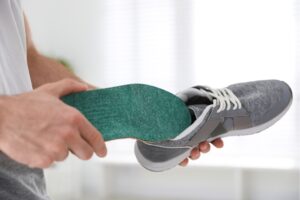Soccer requires the use of your feet more than any other sport. Sharp changes of direction, quick sprints, and being in constant stride for 90 minutes puts large amounts of stress on your feet. Biomechanics and overuse can cause overpronation which commonly results in injuries to the lower body. Such injuries include; Achilles tendonitis, shin splints, bunions and most commonly Plantar fasciitis. Overpronation occurs when the arches of the foot fall (flat feet) and strain the muscles and tendons in your feet. Overpronation describes the way in which weight falls and transfers when you step. Orthotic insoles correct overpronation and realign your gait.
Common Risk Factors
Age: Arches of feet do not fully develop until around the age of 5. Overpronation is a result of flat feet meaning all people over the age of 5 may be at risk.
Job Related Factors: Throughout the day you are constantly on your feet. This puts a lot of force on your feet and when you add sports, this creates lots of stress on your feet causing you to be in pain.
Fitness Level: Deconditioning and training for the new season doesn’t mean you need to spend all day overworking yourself. Doing too much too soon leaves you at risk of getting injured.
Treatment and Prevention
Soccer is routinely associated with lower body injuries due to sport-specific footwear design, biomechanics and loading patterns. Plantar heel pain is the most common complaint voiced by athletes of all disciplines, especially soccer players. The plantar facia or connective tissue of heel and toes can become inflamed from overuse and repetitive stress or wear and tear. This inflammation causes a stabbing pain in the heel and the sensation of walking on needles. Heel pain caused by plantar fasciitis is responsible for 10% of visits to sports clinics. Treatment of this pain must focus on ways to diminish forces on the ankle and foot during play including
- Orthotic shoe inserts that reduce impact and distribute weight properly over the foot in sport-specific movements;
- Adjustable orthotics to fit the demands of different play styles and positions (eg, backward vs forward running, playing on one side of the field) and issues of symmetry as a result of limb dominance;
- Low profile inserts that allow for biomechanical corrections with each step.
Case Study
Methods: The ankle movement extent discrimination apparatus (AMEDA), a testing device developed to evaluate active ankle function when bearing weight was used to test the effects of orthotic inserts in soccer cleats. 17 members of the 2000 Australian Women’s national team participated in this study. These women were tested in bare feet, their own pair of cleats, and a single own cleat with a textured replacement insole.
Results: Movement scores were much worse when the squad wore their personal cleats, compared to the barefoot data collected simultaneously. Switching standard insoles for textured insoles in the cleats returned movement to that of barefoot levels.
Conclusions: The active ankle movement scores of an athlete wearing cleats with smooth standard inserts proposes that textured insoles in cleats could reduce the risk of long term or short-term injury in said athletes. Textured insoles would supply the necessary responsiveness for accurate positioning of the foot.
References
Pande , P. (2017, January 3). Plantar fasciitis: Clinical concerns in cleated sports: Lower Extremity Review Magazine. Lower Extremity Review Magazine | Rehabilitation • Trauma • Diabetes • Biomechanics • Sports Medicine. Retrieved September 26, 2022, from https://lermagazine.com/article/plantar-fasciitis-clinical-concerns-in-cleated-sports-2
Waddington, G., & Adams, R. (2003, April 1). Football boot insoles and sensitivity to extent of ankle inversion movement. British Journal of Sports Medicine. Retrieved September 26, 2022, from https://bjsm.bmj.com/content/37/2/170.short#article-bottom



